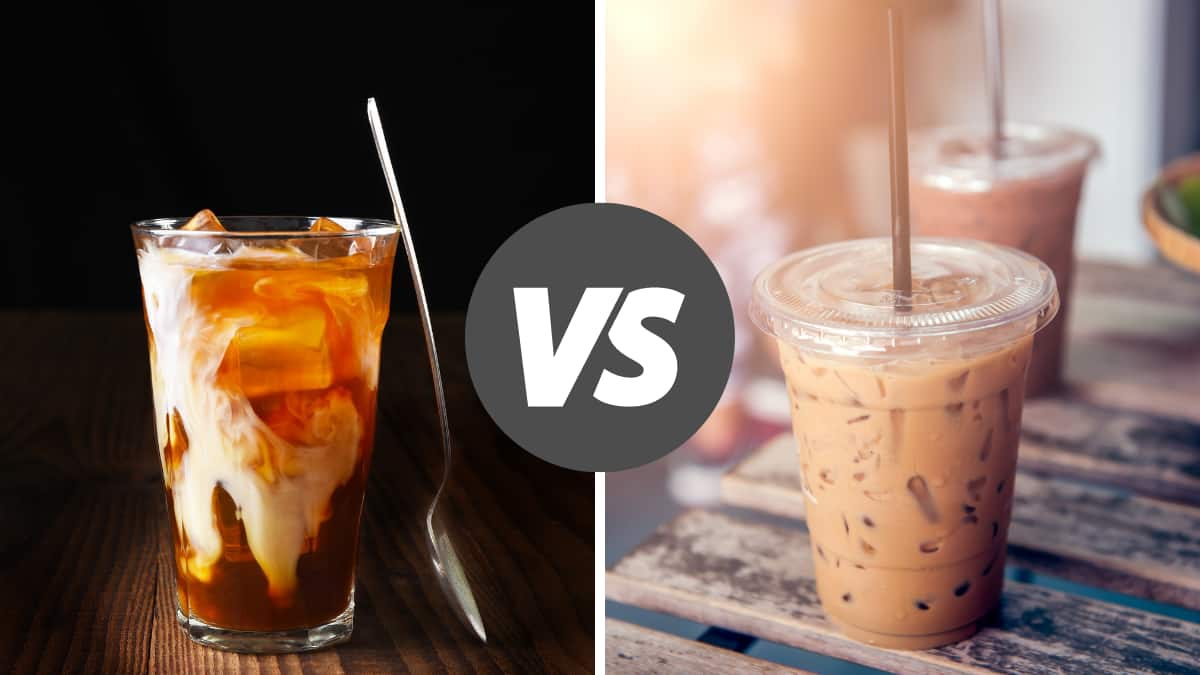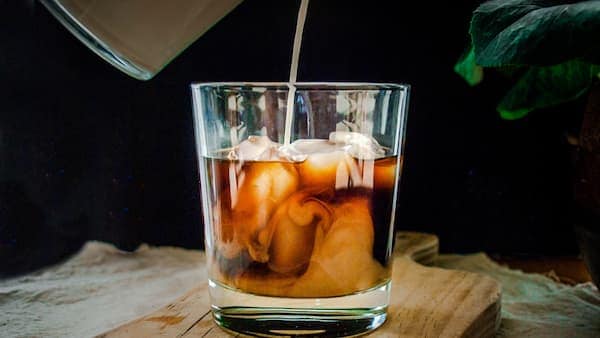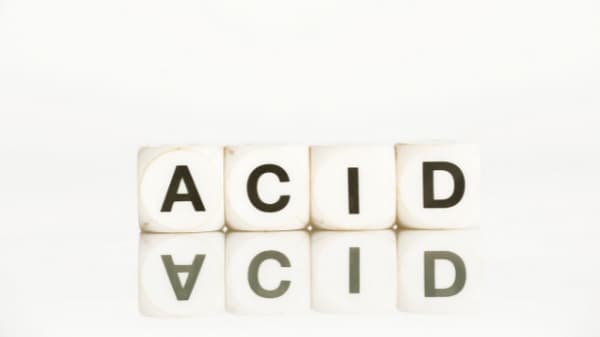Cold Brew VS Iced Coffee Compared
When the weather’s hot, nothing beats a refreshing cold coffee. The sound of iced cubes tinkling in a mason jar. Delicious coffee flavors and a cold respite from the heat. What’s not to love?
Sometimes you might see coffee shops offering both traditional iced coffee and cold brew coffee. Why? Aren’t they both coffee served over ice?
Not exactly. These two drinks use very different brewing methods to achieve very different flavors.

Cold Brew vs Iced Coffee Compared
Brew Water Temperature
When comparing cold brew vs iced coffee, the first major difference to consider is the temperature of the water used to brew the coffee grounds.
As the name suggests, cold brewed coffee uses cold (or room temperature) water to steep coarsely ground coffee. No heat is involved at any point when making cold brew.
Iced coffee, on the other hand, does use hot water. That’s because the first step to making iced coffee is to make regular hot coffee.
You can brew the hot coffee using a drip coffee maker, pour over, or espresso machine. Basically, any brewing method that uses hot water to extract the coffee will work.
The temperature of that water will be the same as if you were brewing yourself a hot cup of coffee. (So somewhere between 195 to 205 degrees Fahrenheit for the best coffee extraction.)
After brewing the coffee, you either let it cool or immediately pour it over ice. I prefer cooling the coffee before adding it to the ice.
Pouring hot liquid directly onto ice will cause some of it to melt. This leaves you with a more watered down flavor before you’ve even enjoyed the first sip.
That said, coffee connoisseurs will tell you that the flavor of coffee deteriorates as it cools. They’re not wrong! Coffee oxidizes when exposed to air.
Oxidization deteriorates flavorful compounds in the coffee, giving it a stale quality. Also, our taste receptors pick up bitter flavors more easily at lower temperatures.

But I prefer a strong, slightly suboptimal flavor to a weaker coffee — regardless of how ‘better’ that taste may be. Plus, adding milk to my iced coffee helps minimize the bitterness.
A compromise might be to pre-freeze cubes of coffee to add to your hot brew. This adds an extra bit of work and doesn’t solve so much as reduce the flavor problems. But it’s an option if you want to try other methods for preparing your iced coffee.
Regardless of what inevitably happens when you put ice in liquid, what else does brew temperature have to do with taste?
Temperature impacts extraction time. Hotter water extracts coffee grounds faster than cold water. (Think about what happens when you drop a teabag in cold water versus water straight off the boil.)
This means that room temperature water will extract cold brew faster than cold water. Whether you let that cold brew steep in the refrigerator or on the counter will also affect the final taste.
This temperature difference might not seem as rigid as the range needed to make hot coffees. But temperature variance can still affect the final taste of your cold brew coffee.
Be prepared to experiment with a range of cool brewing temperatures. Make notes as you go along. (Don’t trust your brain to remember initial water temperatures. Especially if your coffee grounds have been steeping overnight.)
Most of all, play around with the relationship between temperature and brewing time.
Brewing Time
The amount of time it takes to brew cold brew vs iced coffee is huge. We’re talking a difference of many hours.
Cold brew steeps unattended for anywhere between 12 to 24 hours. Half a day to a full day is a long extraction period.
This lengthy steep time makes cold brew a more forgiving process than something like a pour over process that requires precise bloom time observations. However, don’t underestimate the significance of time on the final flavor of cold brew.
Since this extraction period is so long, it’s especially important to use coarse ground coffee beans when brewing cold brew. Using finer grounds could lead to over extraction. In other words, a bitter beverage.
Set a timer and write down when you started brewing the coffee. Even if you’re not making a multi-gallon batch of cold brew for paying customers (oops), it still sucks to waste precious coffee beans simply because you forgot to remove the grounds from the brew.
If you’re in a hurry for a cold caffeine fix on a hot summer’s day, iced coffee is the way to go. Remember, iced coffee is simply regularly brewed hot coffee over ice. Regular coffee brews in just a few minutes.
So from start to finish, your iced coffee will be ready to drink much sooner than a cold brew. (Assuming you’ve pre-frozen plenty of ice cubes.)
Again, you can use any brewing method to make your iced coffee. Follow the time, temperature, and grind setting you would use to make a hot cup of coffee.
Acidity
Are you someone who doesn’t bother with home brewing but solely relies on coffee shops to get your fix? If so, you probably don’t care too much about the logistics of making these cold drinks.
But now it’s time to pay attention. Because acidity is where we really start to consider the experience of actually drinking the coffee.
First things first. It’s easy to describe coffee as both bitter and acidic, but these terms are not the same. (In fact, they refer to opposite ends of the pH scale.) If you’re having a hard time remembering the difference, I find it helpful to replace the word acidic with the word sour.
There you are at the register, ready to buy a cold drink. You’re met with that crucial decision: cold brew vs iced coffee?

If you’re not worried about a small difference in price, there’s one question you need to ask yourself. Do you want a classic acidic coffee taste or something more mellow?
Sour coffee is under-extracted. Bitter coffee is over-extracted. Quick brew times extract less complex flavor compounds. All this means that iced coffee tends to be more acidic whereas cold brew tends to be more bitter.
Of course, we’re ideally hoping for a perfect extraction that produces a coffee that’s not too acidic, not too bitter, but just right.
To some extent, the type of coffee beans you use will also affect how acidic your drink is. Light roasted beans retain more acidity than dark roasted beans.
Cold and Iced Coffee Flavor
When I was working as a barista, I would see diehard cold brew customers order their beloved icy drink in the dead of winter.
Presumably, these customers weren’t heading to secret saunas. So what could possibly make people forego a hot cup of joe for something so cold? Flavor.
Iced coffee resembles regular brewed coffee. But cold brew has a distinct taste. It is less astringent than regular coffee. Instead, it offers sweet chocolatey notes and a smooth, rounded mouthfeel. Some people describe the taste as “mellow,” but its unique intensity still packs a punch.
These complex flavors are thanks to the lengthy extraction process.
This cold brewing process produces a coffee concentrate. You’ll most likely want to dilute this liquid before you drink it. The exact ratio of concentrate to water depends on the initial strength of the concentrate and personal preference for how you want your cold brew to taste.
A quick word of caution. Drinking through a straw makes it very easy to suck cold coffee drinks down in record time. No judgment. But remember that cold brew contains more caffeine than iced coffee. (This trait is also thanks to the longer extraction period.)
In the summertime, it can feel like cold brew has a kind of cult following. But some people prefer the brighter iced coffee taste. Iced coffee maintains many of the aromas featured in a hot cup of coffee. Iced coffee likewise features a more acidic taste than cold brew.
Neither cold coffee drink is impervious to the dangers of melting ice. But you might notice this change more in iced coffee which has a more watery flavor profile and lighter mouthfeel to start.
Thirsty for an extra indulgent coffee drink?
Try adding sweetened condensed milk to your cold coffee for a flavorful treat popular in Vietnam. (If you want to make this Vietnamese coffee a little more authentic, use Robusta beans instead of Arabica beans!)
Wrapping Up: Iced Coffee VS Cold Brew
The main difference between cold brew and iced coffee comes down to brew method.
The cold brew method combines low water temperature and low pressure with a very long extraction time. This process produces a rounded taste with chocolate notes.
To make iced coffee, baristas brew hot coffee using any kind of coffee maker. They then pour this coffee over ice to serve.
Iced coffee more closely resembles its hot counterpart, with a thinner profile that is both more aromatic and more astringent.
There’s no winner or loser when comparing cold brew vs iced coffee. Both beverages offer unique coffee flavors, so it comes down to personal preference. Either way, stay cool, stay caffeinated, and enjoy.

